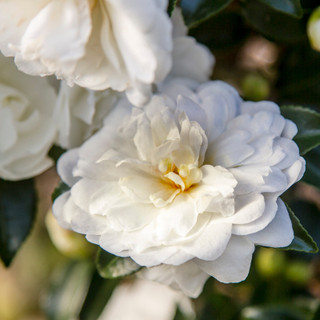Viburnum
Uses:
- Specimen Plants
- Hedges
- Wildlife Gardens
Features:
- Mostly Native Flowering Shrub
- Produces Berries
- Attracts Pollinators
Sunlight:
- Prefers Full Sun, Can Handle Less
- 4+ Hours of Direct Sunlight
Growing Zones:
- 3-10
- What is My Zone?
Viburnums are mostly native shrubs, which are primarily grown for their flowers, berries and beautiful fall foliage. These low maintenance shrubs are also beneficial to pollinators and birds!
Viburnum Plant Information
Viburnum is a genus of shrubs in the Adoxaceae plant family. There are 150-175 species in this plant family. These shrubs are popular due to their fragrant flowers, berries, and color in the fall In cool climates the shrubs are deciduous, and in warmer climates, they can be evergreen. In the fall the leaves turn red or purple. The berries are produced in fall, and are red or blue, or sometimes black in color. Most, but not all, species require another variety to be planted nearby (within 50 feet) to set fruit. Be sure to read each variety’s description to determine what you need to purchase to be successful in growing these spectacular shrubs.
These shrubs are native to temperate regions of North America, Asia and Africa. Birds and insects love viburnums for the flowers and the berries the plants produce. These have winter interest due to the berries lasting through the winter in some cases and can be evergreen in warmer climates.
Viburnums have simple leaves, arranged in an alternating pattern instead of like a ladder along the stem. They are always a woody shrub, and will bloom on the previous year’s wood instead of on new growth. They are a low maintenance plant, needing next to no fertilizer unless your soil is badly depleted.
The Best Way To Use Viburnum
Viburnums are primarily grown for their flowers and berries and beautiful fall foliage. They should be planted with a Southern or Western exposure in your garden or landscape.
Viburnums are cold hardy in Zones 3 to 10, depending on the variety. The shrubs grow 1 to 15 feet tall and are mounding in growth habit. Plant them in well drained soil and in a place where they can get full to partial sun each day.
Gardeners grow viburnum for their 4 season interest in their landscape. They make wonderful specimen shrubs, as well as interesting borders, hedges, or as container plants. Grow these in your yard and the wildlife will thank you as well.
- Flowering shrub with fragrant flowers
-
Blue and red berries
-
Attractive fall foliage
-
1 to 15 feet tall
-
Growing zones 3 to 10
Landscaping Tip: Viburnums are invaluable for landscaping as they are quite versatile. Smaller varieties can be grown in larger containers for patio or porch displays, and larger, more upright varieties are great for larger landscapes. They can be planted in full sun or light shade, providing the solution to the all-too-common problem of continuity in your landscape design.
Viburnum Scientific Classification
| Kingdom: | Plantae |
| Clade: | Tracheophytes |
| Clade: | Angiosperms |
| Clade: | Eudicots |
| Clade: | Asterids |
| Order: | Dipsacales |
| Family: | Adoxaceae |
| Genus: | Viburnum L. |
Viburnum Companion Plants
Plants that go well with viburnum are acid loving annuals, perennials and shrubs. These are our favorite plants to grow with Viburnum.




